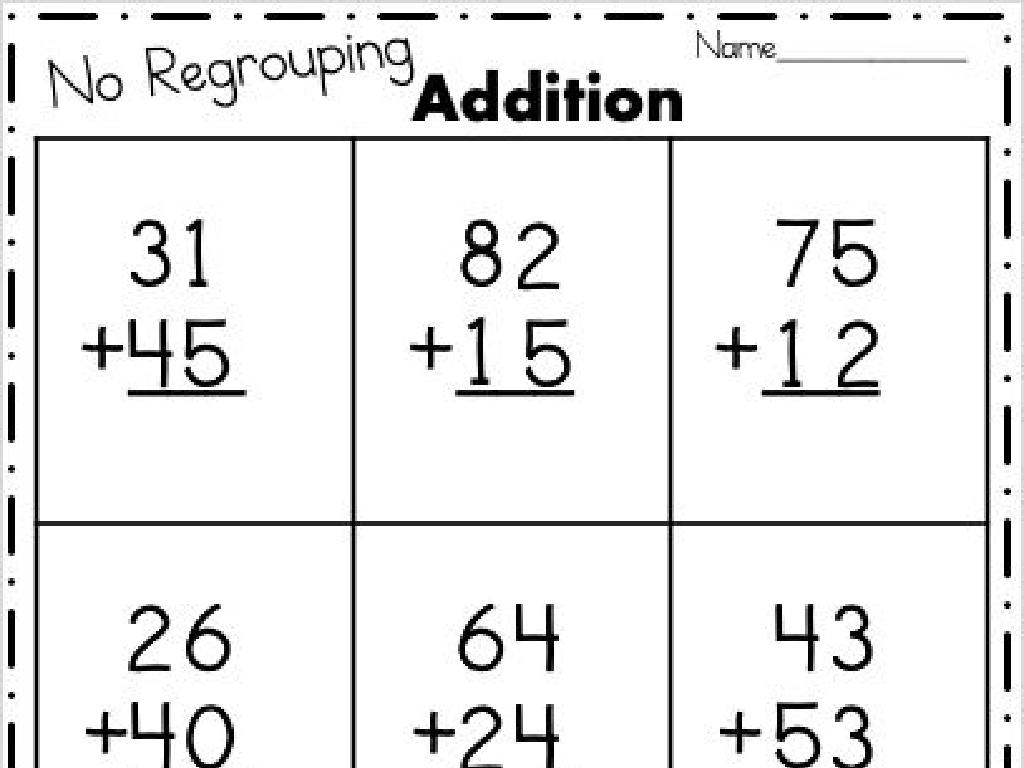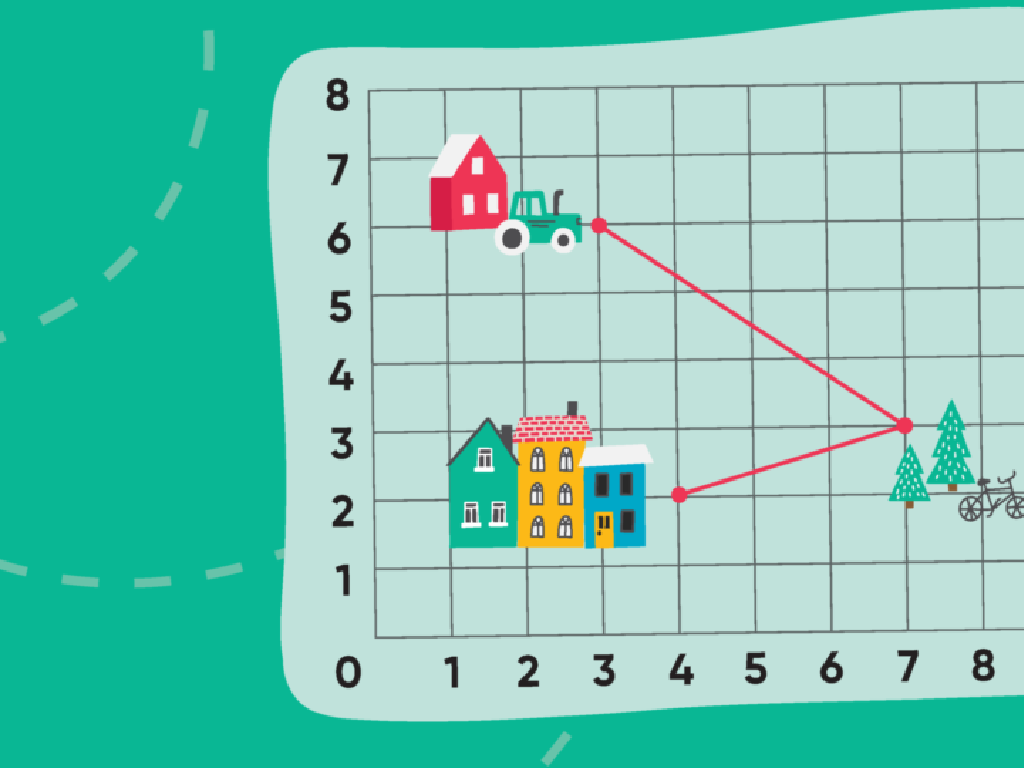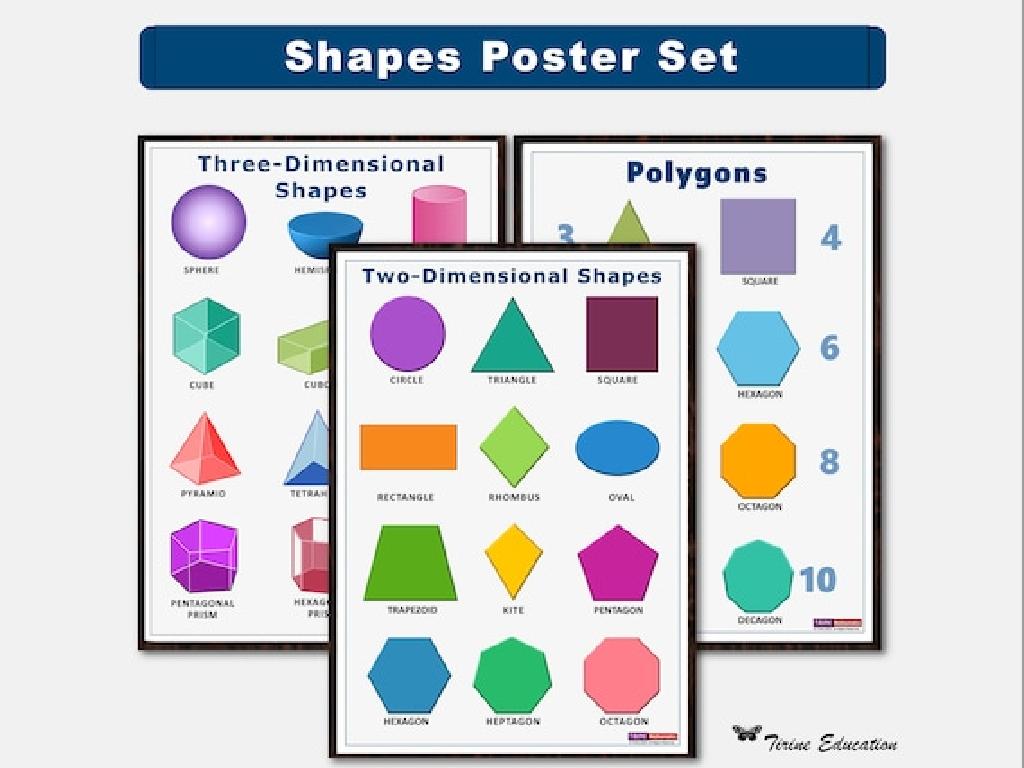Relationship Between Squares And Square Roots
Subject: Math
Grade: Eighth grade
Topic: Square Roots And Cube Roots
Please LOG IN to download the presentation. Access is available to registered users only.
View More Content
Introduction to Square Roots
– Understanding squares and roots
– A square of a number is that number times itself, e.g., 5^2 = 25.
– Square roots as inverses of squares
– Square roots reverse squaring, e.g., 25 = 5, because 5 x 5 = 25.
– Real-life square root applications
– Used in architecture, GPS technology, and finance.
– Exploring square roots in math
|
This slide introduces the concept of square roots, starting with the relationship between squares and square roots. Emphasize that squaring a number means multiplying it by itself and that taking the square root is the opposite process. Provide examples to illustrate the point. Discuss how square roots are used in various real-life scenarios, such as calculating the area of a square, determining the right proportions in building design, or even in algorithms for GPS technology. Encourage students to think of other areas where square roots might be applicable. The goal is to help students see the practical side of square roots beyond theoretical math.
Squares and Square Roots: A Review
– Recap: Squaring a number
– Squaring means multiplying a number by itself, e.g., 3^2 = 3 * 3
– Examples of square numbers
– 1^2 = 1, 2^2 = 4, 3^2 = 9, and so on
– Area models for squares
– Visual squares represent the concept of area, e.g., a 3×3 square has an area of 9
– Relationship to square roots
– The square root is the inverse operation of squaring
|
Begin the lesson by recapping the concept of squaring a number, which is a fundamental operation in algebra. Provide clear examples of square numbers, starting with smaller integers and gradually increasing in complexity. Use area models to visually demonstrate how square numbers can represent actual geometric areas, reinforcing the concept that the square of a number is the area of a square with sides of that length. Finally, introduce the relationship between squares and square roots, explaining that finding the square root is the process of determining the original number that was squared. This will set the stage for understanding how to reverse the operation and solve for square roots in subsequent lessons.
Understanding Square Roots
– Define square roots
– A square root of a number is a value that, when multiplied by itself, gives the number.
– Learn square root symbol
– The symbol for square root is ‘ ‘. For example, 9 means the square root of 9.
– Find roots of perfect squares
– Perfect squares like 4, 9, 16 have whole number square roots: 4=2, 9=3, 16=4.
– Practice with examples
– Use examples like 25=5 to show how to find square roots of perfect squares.
|
This slide introduces the concept of square roots, an essential part of understanding algebra and geometry. Start by defining square roots as a fundamental mathematical operation, the inverse of squaring a number. Show the square root symbol and explain its notation. Focus on perfect squares, which are integers that are squares of whole numbers, and demonstrate how to find their square roots. Provide several examples of perfect squares and their square roots to ensure students can recognize and compute them. Encourage students to memorize the square roots of numbers 1 through 15 to aid in quick recognition.
Square Roots and Area
– Square roots and area relationship
– The square root of an area gives the length of each side of a square.
– Example: Side length from area
– To find a side, take the square root of the area. For example, a square with an area of 49 has sides of 7 units.
– Activity: Area of 64 square units
– Use the relationship to calculate the side length of a square with an area of 64.
– Understanding square roots in geometry
|
This slide introduces the concept of square roots in the context of geometry, specifically relating it to the area of a square. Students will understand that the square root of an area gives the length of each side of a square. For example, if a square has an area of 49 square units, its side length is the square root of 49, which is 7 units. The activity involves applying this knowledge to find the side length of a square with an area of 64 square units, which is 8 units. This exercise helps solidify the understanding of square roots as a geometric concept and prepares students for more complex problems involving square roots and area.
Estimating Square Roots
– Estimating roots of non-perfect squares
– Find the nearest perfect squares and use them as reference points.
– Use number lines for approximation
– Place the non-perfect square on a number line between perfect squares.
– Example: Estimating 10
– 10 is between 9 (3) and 16 (4). Estimate its value.
– Compare 10 to perfect squares
– Observe how 10 is closer to 3 than to 4 on the number line.
|
When teaching estimation of square roots, start by explaining that not all square roots are whole numbers, and we often need to estimate them. Show how to use nearby perfect squares to find a reasonable approximation. Introduce the concept of a number line as a visual aid to place non-perfect squares between the nearest perfect squares. Use 10 as an example, demonstrating that it falls between 9 and 16, which are 3 and 4, respectively. Encourage students to see that 10 is closer to 3 on the number line, leading to an estimate slightly above 3. This exercise helps students grasp the concept of square roots in relation to perfect squares and improves their number sense.
Properties of Square Roots
– Square roots and exponents
– Square root of a number is an exponent of 1/2
– Simplify square root expressions
– Use radical rules to simplify (a*b) = a * b
– Rules for arithmetic with square roots
– Like terms can be combined; a + a = 2 a
– Practical applications
– Apply rules to solve real-world math problems
|
This slide introduces the fundamental properties of square roots, connecting them to exponents by explaining that taking a square root is equivalent to raising a number to the power of 1/2. Emphasize the importance of simplifying expressions with square roots by using radical rules and provide examples. Clarify the rules for adding, subtracting, multiplying, and dividing square roots, noting that only like terms can be combined. Conclude with practical applications to show how these properties are used in real-world scenarios. Encourage students to practice these concepts with various examples to gain a solid understanding.
Solving Problems with Square Roots
– Apply square roots in equations
– Use square roots to find x when given x^2
– Example: Solve x^2 = 49
– x = ± 49, so x can be 7 or -7
– Practice: x^2 = 81, find x
– Calculate x = ± 81, what are the values of x?
|
This slide focuses on applying the concept of square roots to solve quadratic equations. Start by explaining that taking the square root of both sides of an equation is a method to find the value of x when x is squared. Use the example x^2 = 49 to show that x can have two values, 7 and -7, because both numbers squared equal 49. Then, present the practice problem x^2 = 81 and guide students to find x by calculating the square root of 81, which is 9. Remind them to consider both the positive and negative square roots, so x can be 9 or -9. Encourage students to solve the problem on their own and then discuss the answers as a class.
Class Activity: Square Root Bingo
– Receive your unique Bingo card
– Mark squares or roots as called
– Complete a row to win
– Shout ‘Bingo!’ for a prize
|
This interactive class activity is designed to help students practice the relationship between squares and square roots in a fun and engaging way. Each student will receive a Bingo card filled with a mix of squares and square roots. The teacher will call out numbers randomly, and students must identify and mark the corresponding square or square root on their cards. The first student to mark off a complete row (horizontal, vertical, or diagonal) and shout ‘Bingo!’ will be declared the winner and receive a prize. This activity not only reinforces the concept of squares and square roots but also encourages quick mental calculation. Possible variations of the game could include using different patterns on the Bingo card or having multiple winners. Ensure to prepare a list of numbers and their corresponding squares and square roots to call out during the game.
Wrapping Up: Squares and Square Roots
– Recap today’s key points
– Homework: Estimating square roots
– Complete the provided worksheet to practice estimating square roots.
– Practice is key to mastery
– Keep exploring with more examples
– Try finding square roots of numbers around you, like areas of squares.
|
As we conclude today’s lesson, it’s important to review the relationship between squares and square roots. Ensure students understand that every positive number has two square roots, one positive and one negative. For homework, students are expected to complete a worksheet focused on estimating square roots, which will help reinforce their understanding of the concept. Remind students that consistent practice is crucial in mastering mathematical concepts. Encourage them to find square roots in real-life situations, such as calculating the side length of a square with a given area, to further their comprehension and application skills.






